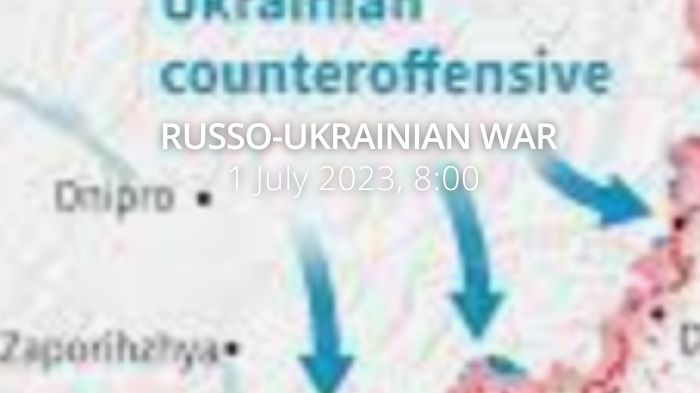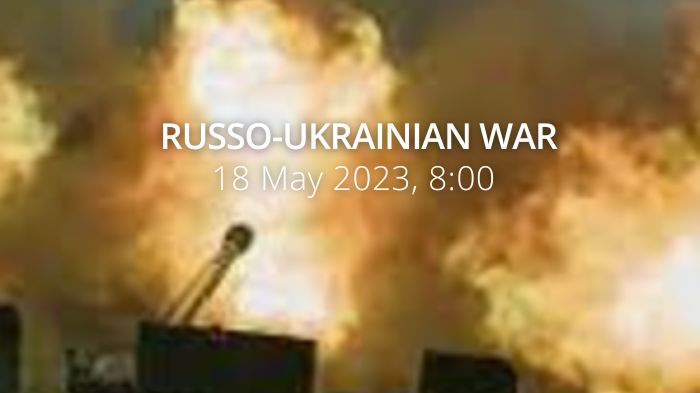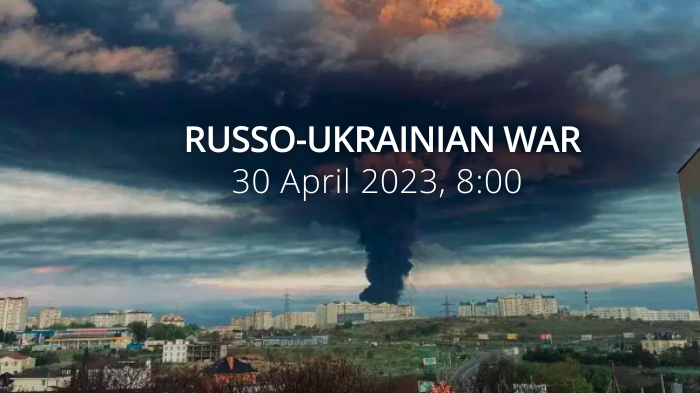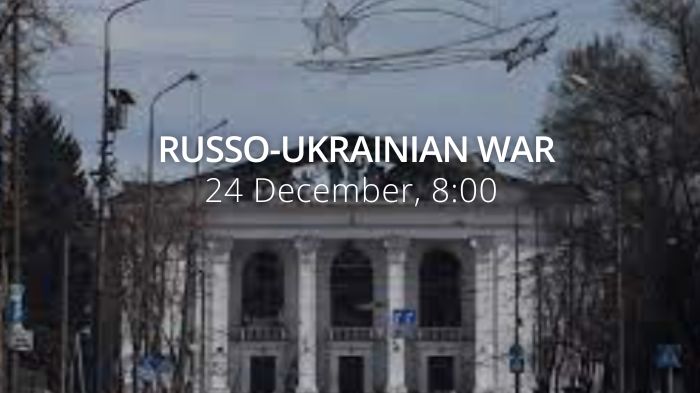Ukrainian forces continue to advance in eastern and southern Ukraine despite lacking essential resources - Zaluzhnyi. Russian forces and officials are gradually leaving the Zaporizhzhia Nuclear Power Plant (ZNPP) possibly in preparation for an intentional “accident” at the facility. The Wagner Group is reportedly still actively recruiting personnel within Russia.
https://twitter.com/EuromaidanPress/status/1675202860173209602
Daily overview — Summary report, June 31
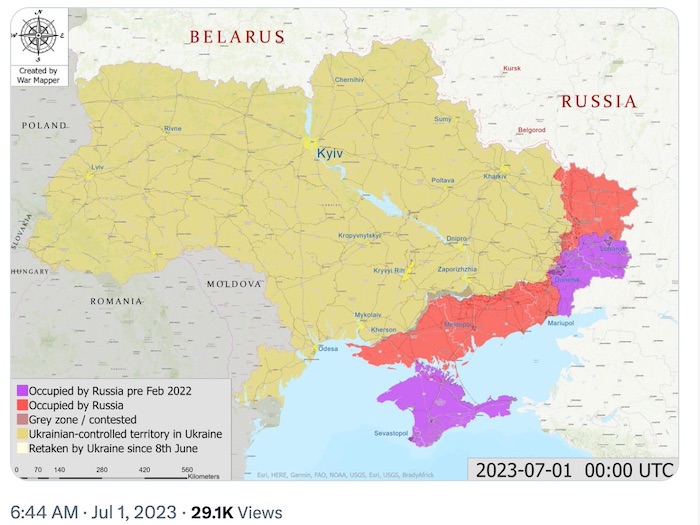
The General Staff’s operational update regarding the Russian invasion as of 18.00 pm, June 31, 2023 is in the dropdown menu below:
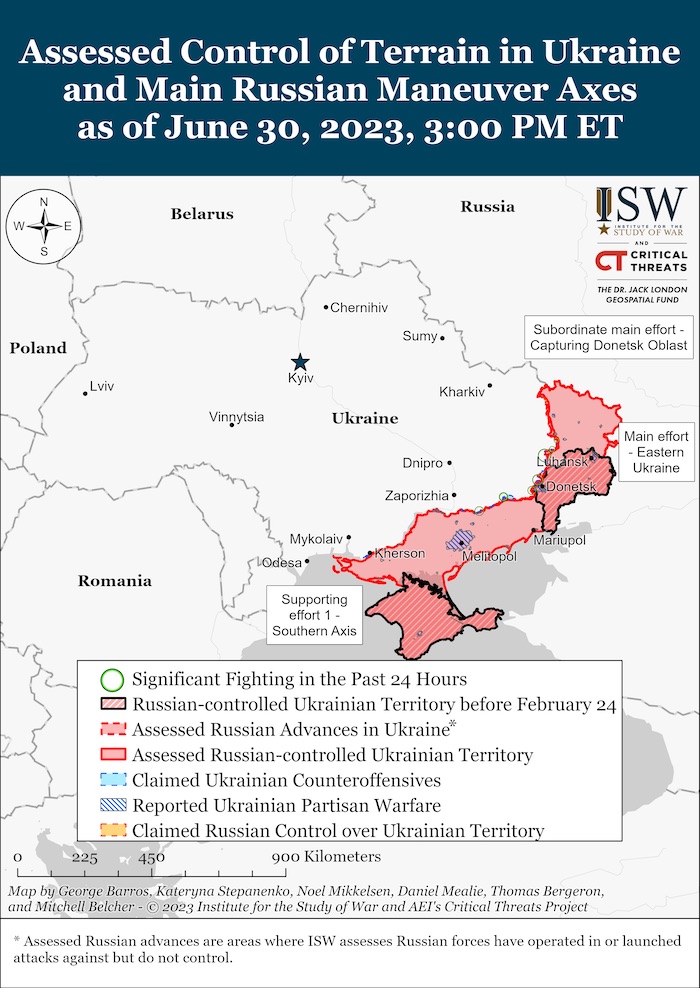
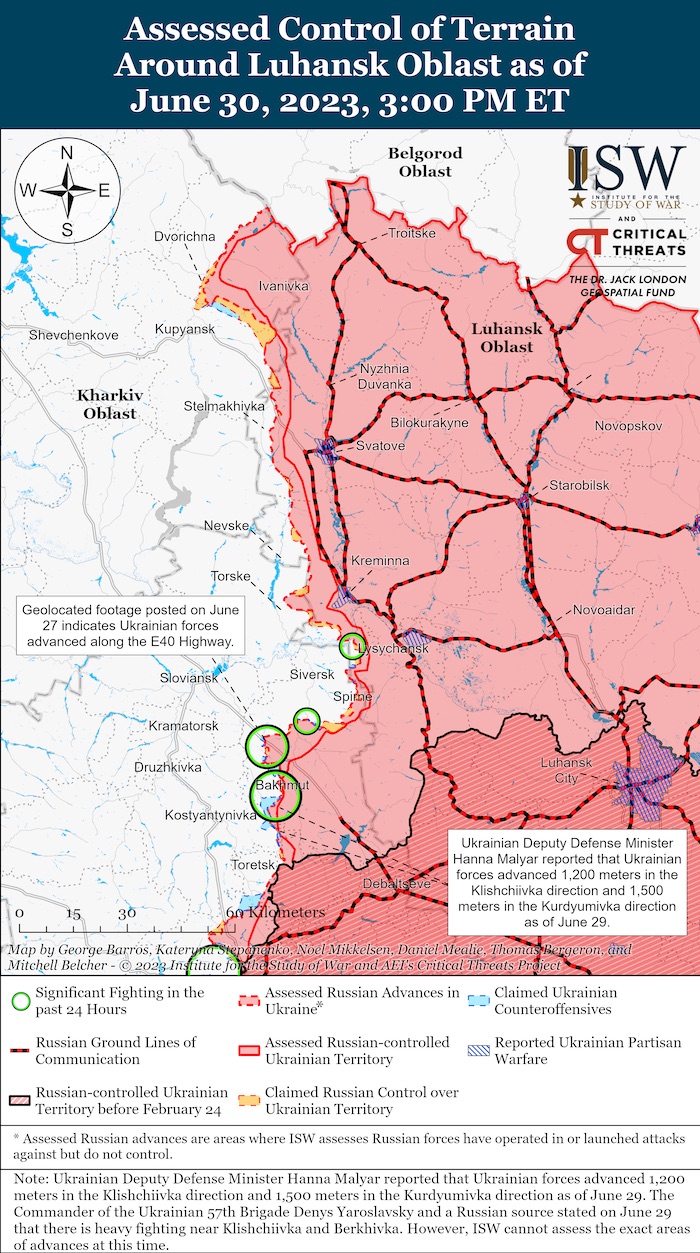
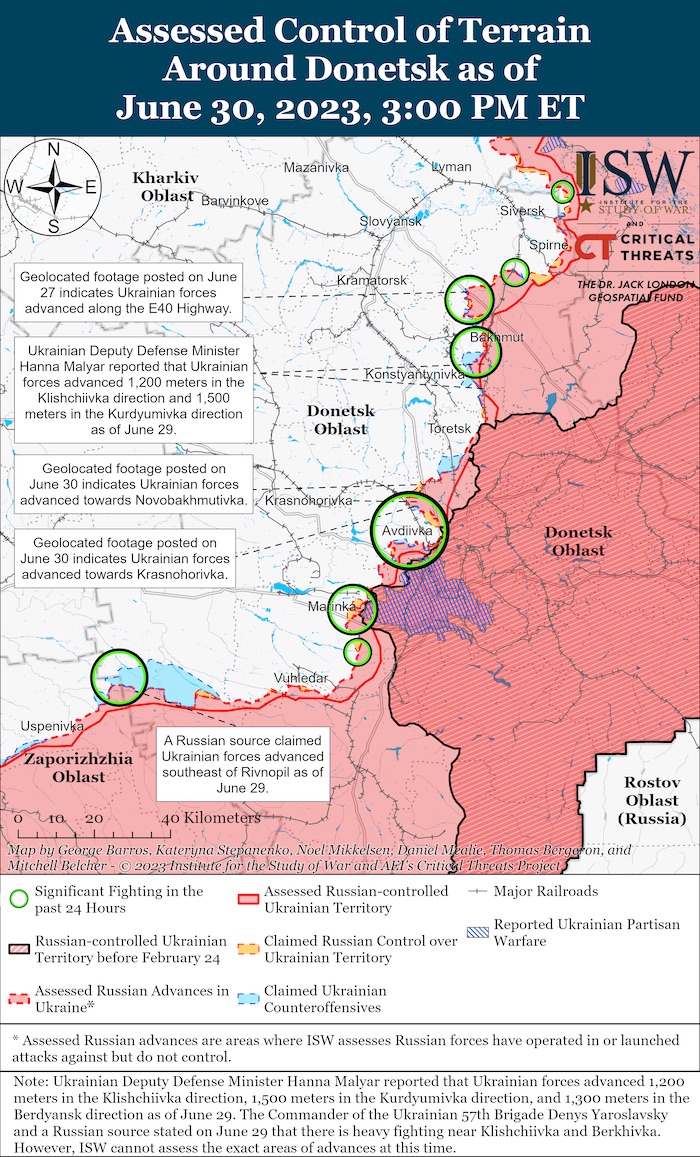
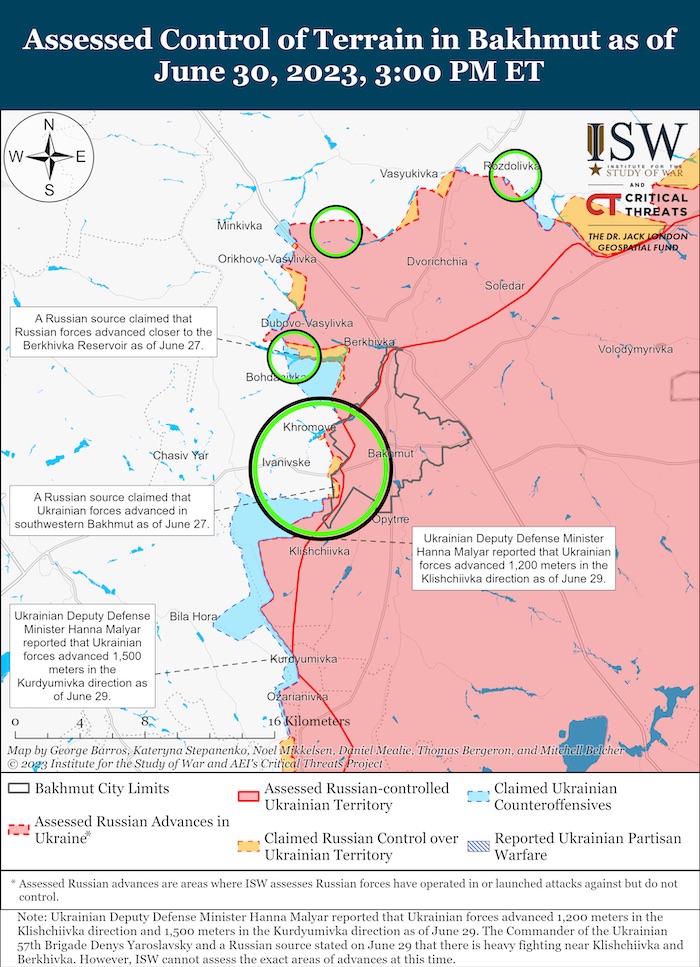
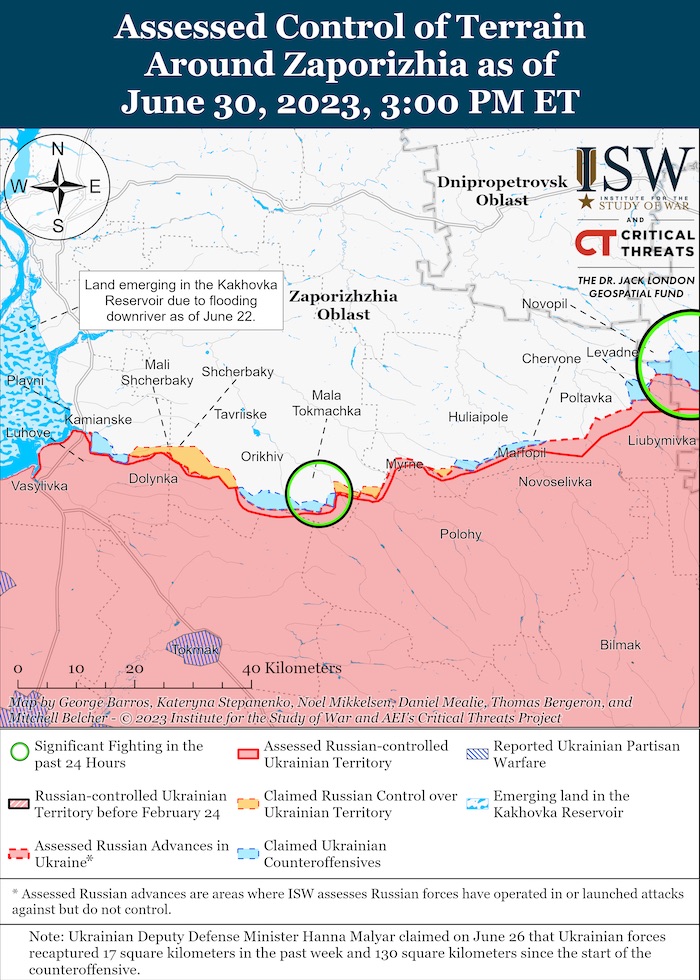
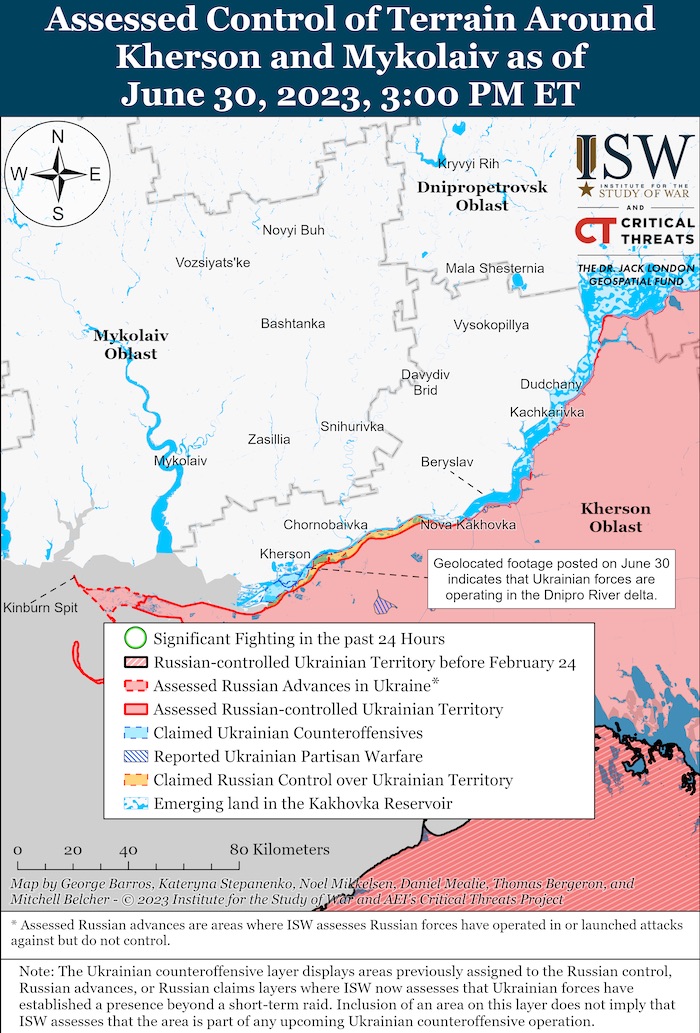
Military Updates
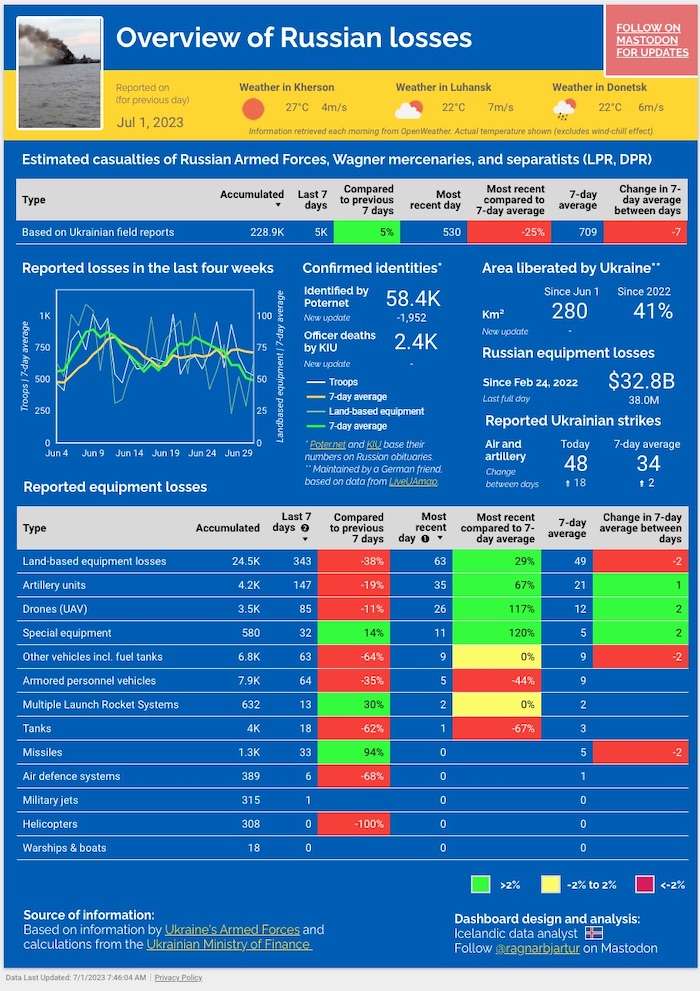
Russia significantly increases military spending in 2023 – British Intel. Russia’s military expenditure in 2023 accounts for approximately 22 percent of the Russian Government’s total budget, British intelligence reported in its daily update on the Russo-Ukrainian war on 30 June. In a June 2023 report, the Stockholm International Peace Research Institute (SIPRI) assessed that Russia’s military spending budget for 2023 is around 6.6 trillion rubles (USD 85,8 billion). According to British intelligence, such military spending equates to about 4,4 percent of Russian GDP compared with 3,6 percent in 2021, before the full-scale invasion of Ukraine.
Ukrainian troops continue offensive operations at Melitopol, Berdiansk, Bakhmut directions – military. According to Andrii Kovaliov, the spokesman for the General Staff of the Armed Forces of Ukraine, the Ukrainian Defense Forces continue to conduct offensive operations and have “partial success” in the Melitopol and Berdiansk sectors in Ukraine’s south, and north of Bakhmut in the east.
Wagner Group still recruiting despite mutiny, BBC finds. The Russian mercenary Wagner Group is still recruiting fighters across Russia, days after staging a mutiny against Russia’s Defense Ministry, BBC found after making calls to a dozen of Wagner recruitment offices in Russia.
Ukraine air defenders down ten of 13 Shahed drones. According to Ukraine’s Air Force Command, overnight into 30 June 2023, the Russian forces attacked Zaporizhzhia Oblast with 13 Iranian-made Shahed-136/131 kamikaze drones, and four anti-air missiles launched from the S-300 systems. Air defenses destroyed ten of the drones, the Command says. Russians launched the Shaheds from Primorsko-Akhtarsk on the eastern coast of the Sea of Azov. The drones and missiles attacked “military and infrastructure facilities in Zaporizhzhia Oblast,” according to the Air Force.
Wagner troops will no longer fight in Ukraine, spy chief Kyrylo Budanov says. In an interview with Ukrainska Pravda, Kyrylo Budanov, Ukraine’s military intelligence chief, said Wagner mercenaries would no longer fight in Ukraine. According to him, it is a consequence of the failed insurrection of the Wagner group, which exposed the vulnerabilities of the Russian leadership. “Once again, the myth of the invincibility of the Russian regime has been shattered. Losses have been inflicted on the Russian military and the Aerospace Forces. Furthermore, the Wagner PMC will no longer participate in combat operations on Ukrainian territory. And this is the most effective unit of Russia, which could achieve success at all costs,” he stressed.
Fierce battles rage in Kherson Oblast near a small Ukrainian bridgehead next to occupied Oleshky town as Russian attackers face Ukrainian traps and resilient resistance.https://t.co/Vlwhf0nugi
— Euromaidan Press (@EuromaidanPress) July 1, 2023
According to British Defence Intelligence, (last 48 hours):
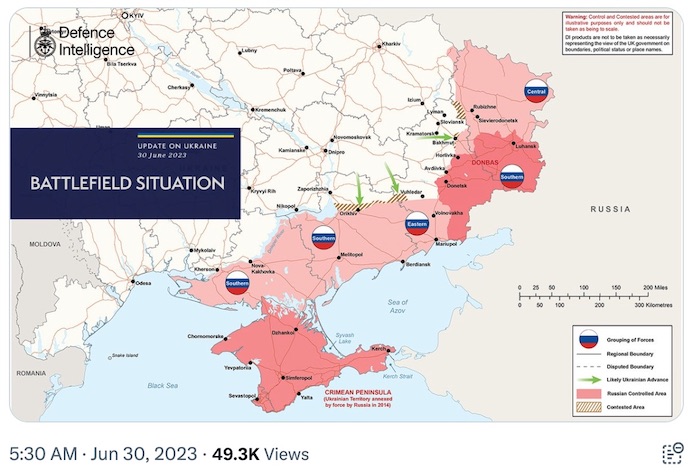
- Since around 23 June 2023, Ukrainian forces have almost certainly restarted deploying personnel to the east bank of the Dnipro River in Kherson Oblast, near the ruined Antonovskiy Bridge.
- Fighting intensified on the east bank from 27 June 2023. The defending Russian force includes elements of Russia’s 7th Guards Air Assault Division, part of the Dnipro Group of Forces (DGF).
- In recent weeks, Russia has highly likely reallocated elements of DGF defending the bank of the Dnipro to reinforce the Zaporizhzhia sector. Combat around the bridge head is almost certainly complicated by the flooding, destruction and residual mud from the collapse of the Kakhovka Dam on 06 June 2023.
Losses of the Russian army
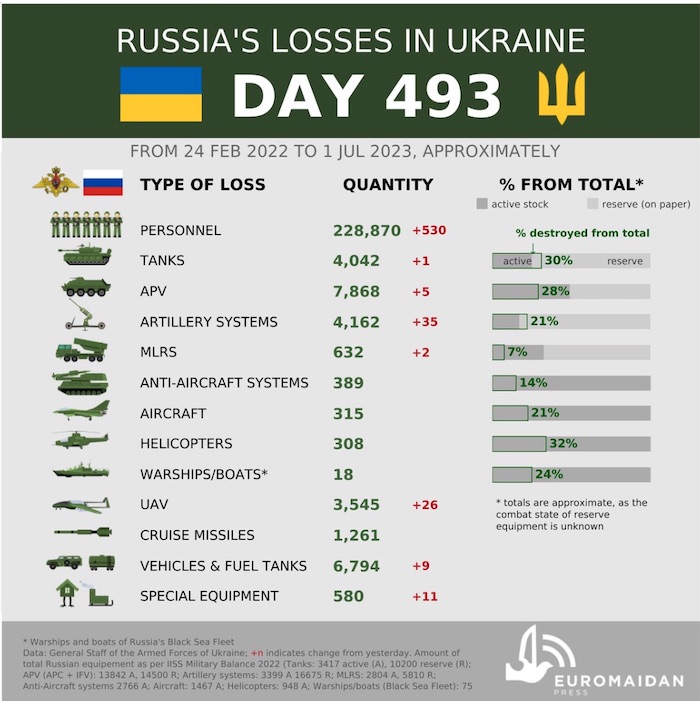
https://twitter.com/EuromaidanPress/status/1675188275902914561
Humanitarian
Russian occupation administration intensifies repressions in Luhansk Oblast. According to Ukraine’s National Resistance Center, local residents of the occupied Luhansk Oblast are prohibited from communicating with territories under Ukrainian control.
Russian shelling destroys school in Donetsk Oblast, a teacher and accountant killed. A Russian artillery strike hit a high school building in Serhiyivka (Donetsk Oblast, eastern Ukraine), the Donetsk Oblast Prosecutor’s Office reported. Russian forces attacked the village of Serhiyivka at around 11:20 am, probably with multiple rocket launchers, according to the Donetsk Oblast Prosecutor’s Office. There were 12 civilians inside the school during the shelling: teachers and technical staff.
Architects dream up a future, postindustrial Mariupol. A group of Ukrainian architects and designers has published a project to restore Mariupol, the seaside city razed to the ground by Russian occupiers. Titled “Re: Mariupol,” it offers a futuristic take at the once-industrial city whose factories were dedicated by Russian bombs.
Environmental
Kakhovka Dam destruction direct losses amounted to USD 2 bn for Ukraine. Ukraine has suffered direct losses of at least $2 billion due to the destruction of the Kakhovka Hydroelectric Power plant by Russian forces on 6 June, Ukraine’s Ministry of Economy reported, referring to an initial assessment by the KSE Institute of the Kyiv School of Economics. Indirect losses are much higher.
Russians reduce their presence at Zaporizhzhia nuclear plant – Ukraine intel. Russians reduced their presence at the Zaporizhzhia Nuclear Power Plant (ZNPP), instructing the personnel remaining at the plant to “blame Ukraine in case of any emergency,” Ukraine’s Main Directorate of Intelligence (HUR) reported on 30 June. The HUR says the occupation contingent is leaving the premises of the ZNPP, three Rosatom employees, who were in charge of the Russians, were among the first to leave the plant. Ukrainian employees who signed a contract with Rosatom also received recommendations to evacuate from ZNPP territory by 5 July.
Zelenskyy meets Greta Thunberg in Kyiv to address the war’s effect on ecology. On 29 June, Ukrainian President Volodymyr Zelenskyy met with Swedish environmental activist Greta Thunberg and members of the International Working Group on the Environmental Consequences of War in Kyiv to address ecological damage from the Russian war. The working group includes former Deputy Prime Minister of Sweden Margot Wallström, Vice-President of the European Parliament Heidi Hautala, former President of Ireland Mary Robinson, and Thunberg.
Legal
Alleged arrest of Surovikin possibly indicates that Russia intends to purge commanders viewed as disloyal to Kremlin – ISW. According to the Institute for the Study of War (ISW), Russian sources continue to speculate that Wagner’s rebellion is already having widespread impacts on the Russian command structure and has prompted “large-scale purges” within Russian forces.
Support
EU leaders to define “security commitments” EU set to provide to Ukraine. EU leaders decided to support Ukraine for “as long as it takes” by agreeing to provide “future security commitments” at the two-day summit of the European Council on 30 June, Euronews reported. The agreement aims to replace the bloc’s band-aid approach to Ukraine with long-term financial, humanitarian, and military assistance over the coming years so that Ukraine could not only “survive the war and arrive at the negotiating table with Russia in a powerful position,” but also “integrate further into the EU and NATO to facilitate membership.”
World Bank approves USD 1.5 bn loan to strengthen Ukraine’s social protection system. On 29 June, the World Bank approved a $1.5 billion loan for Ukraine to mitigate the impacts of Russia’s invasion, World Bank reported. The lending operation, guaranteed by the Japanese government, will support three main areas of government reforms: relief to households, reforms to transparency over public resources, and support for markets.
US leaning toward sending Ukraine cluster munitions, may announce supplies next month – NBC sources. The US is leaning toward providing cluster munitions to Ukraine, and the announcement could come as early as next month, two senior US officials told NBC News. “A third US official said the US is considering providing dual-purpose improved conventional munitions, or DPICMs, to Ukraine but declined to provide any timeline for an announcement,” according to NBC News. DPICMs are surface-to-surface warheads designed to detonate and scatter numerous smaller munitions or bomblets across wide areas, resulting in significantly broader devastation than individual rounds. These projectiles can be shaped charges capable of penetrating armored vehicles, or alternatively, they can fragment, increasing the threat level and lethality against personnel.
New Developments
Poland has arrested a Russian professional athlete suspected of spying for Russia.
The Polish Internal Security Agency said that 14 other suspects had already been arrested as part of the investigation into the alleged spy ring.https://t.co/De1cM2UCk4
— Euromaidan Press (@EuromaidanPress) June 30, 2023
Poland applies to NATO to join Nuclear Sharing program – Poland’s Prime Minister. Poland Prime Minister Mateusz Morawiecki said on 30 June that Poland wants to become part of the NATO nuclear exchange program because of Russia’s deployment of tactical nuclear weapons in Belarus.
Record-high 89% of Ukrainians want to join NATO, poll shows. Public support for Ukraine’s accession to NATO among Ukrainians has increased once again, reaching history’s highest level, according to the Kyiv International Institute of Sociology (KMIS) survey published on 30 June. In May 2023, the KMIS conducted a nationwide poll in Ukraine to find out how many Ukrainians support Ukraine’s accession to NATO and the European Union (EU) and how many Ukrainian citizens trust President Volodymyr Zelenskyy, Ukraine’s Armed Forces, and various government institutions.
Alleged Wagner mercenary opens fire at airport in Moldova A foreigner opened fire inside Chisinau International Airport, Moldova’s Ministry of Interior reported. The man came to Moldova from Türkiye, according
to Puls Media, Moldova’s news agency. After he was denied entry to Moldova, the man attacked an airport security employee, whom he disarmed and shot dead, Puls media reported. Moldova’s police confirmed that two people died during gunfire ahttps://euromaidanpress.com/2023/06/30/alleged-wagner-mercenary-opens-fire-at-airport-in-moldova/?swcfpc=1t the country’s main international airport today. All flights were delayed and passengers evacuated until police neutralized the shooter, Moldova’s police spox Diana Fetko said.
Assessment
- On the war.
The Institute for the Study of War has made the following assessment as of June 30, 2022:
Ukrainian forces conducted counteroffensive operations in at least three sectors of the frontline on June 30. The Ukrainian General Staff reported that Ukrainian forces continued offensive operations in the Melitopol (western Zaporizhzhia Oblast) and Berdiansk (eastern Zaporizhzhia Oblast) directions.[1] The Ukrainian General Staff added that Ukrainian forces achieved partial success on the Levadne-Pryyutne line on the administrative border of Donetsk and Zaporizhzhia oblasts and on the Mala-Tokmachka-Ocheretuvate line in western Zaporizhzhia Oblast. Ukrainian forces also reportedly consolidated newly reached lines in the Pryvillia-Zalizyanske direction north of Bakhmut and are continuing to exert pressure on Bakhmut’s flanks. Ukrainian Deputy Defense Minister Hanna Maliar reported that Ukrainian forces are confidently advancing on Bakhmut’s flanks and that Russian forces have transferred a large number of troops to the area.[2] Maliar added that Ukrainian forces are advancing with varying degrees of success in southern Ukraine, advancing one kilometer on some days and advancing less on others.[3] Select Russian sources also claimed that Ukrainian forces counterattacked around Kreminna and on the Donetsk City-Avdiivka frontline.[4]
Ukrainian Commander-in-Chief General Valerii Zaluzhnyi stated on June 30 that Ukrainian forces continue to advance in eastern and southern Ukraine despite lacking essential resources.[5] Zaluzhnyi said that the Ukrainian forces are still making battlefield gains even if they advance only 500 meters per day. Zaluzhnyi also stated that Ukrainian forces are continuing to use Western-provided armored vehicles and tanks in combat instead of saving them for “parades” when responding to a question about military equipment losses. Zaluzhnyi noted that Ukraine needs aircraft in order to support its counteroffensive efforts, which are hindered by the lack of air superiority.
The Russian information space is reacting disproportionately to the Russian military’s failure to drive a small Ukrainian force from east (left) bank Kherson Oblast. Russian milbloggers have complained for nearly two weeks that Russian forces have failed to push a very small Ukrainian force – reportedly of up to 70 personnel – from their entrenched positions underneath the eastern span of the Antonivsky Bridge.[6] The milbloggers complained that the Russian military command blindly ordered Russian forces to retake the area under a span of the Antonivsky Bridge on the east bank, resulting in significant losses among Russian personnel and armored vehicles due to Ukrainian artillery fire and remotely laid mines.[7] The milbloggers called on Russian forces to conduct “accurate” strikes against both the spans of the bridge on each riverbank to prevent Ukrainian forces from using the bridge’s approach spans as cover against Russian air and artillery fire, which the milbloggers previously criticized as inaccurate and ineffective. Russian forces launched an Iskander ballistic missile strike against the east bank span of the Antonivsky Bridge on June 30, though the extent of the damage is currently unclear.[8] Some milbloggers claimed that the strike damaged enough of the standing bridge span to prevent Ukrainian forces from using it as cover, while other milbloggers complained that the strike only partially damaged the bridge and that Russian infantry has resumed attempts to clear Ukrainian positions elsewhere in the area.[9] Ukrainian Air Force Spokesperson Colonel Yuriy Ihnat stated on June 1 that Russian forces are conserving Iskander missiles due to a shortage, underscoring the oddity of Russian forces using one of these missiles against a 70-person light infantry element under the approaches to an already destroyed bridge.[10] Some milbloggers claimed that Russian forces used TOS-1A thermobaric artillery systems – a scarce military district-level asset – to strike the Ukrainian positions under the bridge after the Iskander strike.[11] One milblogger complained that the Russian 8th Artillery Regiment (22ndArmy Corps, Black Sea Fleet) does not have enough ammunition to strike the Ukrainian positions.[12] Russian President Vladimir Putin awarded the “guards” honorific to the 8th Artillery Regiment on June 30, which will not help the regiment dislodge the Ukrainian forces.[13]
The severe milblogger response to the Russian military command’s decision making demonstrates that Russian milbloggers have not rallied around the Russian military command in the aftermath of Wagner’s armed rebellion. Some milbloggers claimed that the Ukrainian presence is limited and that there is no significant threat of Ukrainian forces breaking out of their foothold on the east bank.[14] Milbloggers complained that the Russian military command is unnecessarily impaling Russian forces on Ukrainian remotely laid mines and compelling Russian forces to put heavy military equipment in range of Ukrainian artillery fire.[15] One milblogger explicitly blamed Russian “Dnepr” Group of Forces (Kherson Oblast) Commander Colonel General Oleg Makarevich, reportedly headquartered in Rostov-on-Don, for these operations, implying that there is no relevant commander closer to the front line responsible for east bank Kherson Oblast.[16] Wagner Group forces notably surrounded the Russian Southern Military District (SMD) headquarters in Rostov-on-Don, which appears to include the “Dnepr” Grouping headquarters, during its armed rebellion.[17] The rebellion and surrounding of the grouping headquarters notably did not stop Russian milbloggers from criticizing the Russian military command, with one milblogger calling for someone to travel to Rostov to beat up Makarevich.[18] The harsh tone of this Russian information space response is reminiscent of the response to the Russian military command’s failed efforts to take Vuhledar in western Donetsk Oblast in November 2022 and February 2023.[19]
Ukrainian intelligence reported that Russian forces and officials are gradually leaving the Zaporizhzhia Nuclear Power Plant (ZNPP) possibly in preparation for an intentional “accident” at the facility. The Ukrainian Main Military Intelligence Directorate (GUR) reported on June 30 that the Russian contingent at the ZNPP is gradually leaving the facility and that three employees of Russian state nuclear energy company Rosatom who managed the facility have recently left for Russian occupied Crimea.[20] The GUR reported that Ukrainian employees at the ZNPP who have signed contracts with Rosatom received instructions that they must evacuate the facility by July 5.[21] The GUR reported that Russian forces are decreasing patrols around the ZNPP itself and in neighboring Enerhodar and that workers at the ZNPP have also received instructions to blame Ukrainian forces in the event of an emergency.[22] ISW has not observed visual confirmation of Russian units leaving the ZNPP or the immediate area as of June 30. GUR Chief Kyrylo Budanov stated on June 30 that Russian forces have prepared for an artificial disaster at the facility.[23] Ukrainian officials in Mykolaiv, Kherson, Zaporizhzhia, and Dnipropetrovsk oblasts oversaw emergency preparation exercises for a possible “accident“ at the ZNPP on June 29.[24] Ukrainian Energy Minister Herman Halushchenko reported that Ukrainian officials lack the ability to monitor the ZNPP closely enough to become instantly aware of an “accident” at the ZNPP.[25] The president of Ukrainian nuclear energy operator Energoatom, Petro Kotin, stated that the closest radiation censors on the right (west) bank of the Kakhovka Reservoir would alert Ukrainian officials within a few hours of a potential release of radiation at the ZNPP.[26]
Russian forces remain unlikely to cause an intentional “accident” at the ZNPP, and Russia is likely continuing to use the threat of an intentional radiological incident to attempt to constrain Ukrainian counteroffensive actions and Western support for Ukraine ahead of the upcoming NATO summit. ISW has previously assessed that Russian forces would not be able to control the consequences of an intentional radiological incident at the ZNPP and that a radiological incident could further degrade Russia’s ability to cement its occupation of southern Ukraine by leaving areas uninhabitable and ungovernable.[27] The likely Russian destruction of the Kakhovka Hydroelectric Power Plant (KHPP) dam also adversely impacted Russian forces, however, and possible Russian plans to sabotage the ZNPP cannot be ruled out. Russian forces could conduct several possible radiological man-made incidents at the ZNPP, some more serious than others. Russian forces could discharge irradiated water from the ZNPP into the Kakhovka Reservoir to disrupt a potential Ukrainian crossing of the now largely drained reservoir. Russian forces could also attempt to create a radiological plume to cover a larger area of southern Ukraine, although the reactors are designed to make doing so difficult. The prevailing winds in Zaporizhzhia Oblast are most often from the north from June 9 to September 3, although forecasted wind directions in the area following the reported July 5 evacuation deadline include days of predominantly easterly winds.[28] A radiation plume from the ZNPP would most certainly affect the Russian forces in Zaporizhzhia and Kherson oblasts and possibly in Crimea and would likely impact the Russian forces to a greater degree than the Ukrainian forces given the usual direction of the wind in the area. Russian forces could conduct a man-made “accident” that creates a smaller radiological radius immediately focused on preventing Ukrainian advances near the ZNPP itself. None of these options provide more military benefit for Russian forces than the likely consequences they would create. Ukraine, for its part, would derive no benefits from causing a radiological incident at the ZNPP remotely consonant with the enormous price it would pay in irradiating lands and peoples it seeks to liberate and hindering its own ability to advance in the area, making Russian informational efforts to set conditions for blaming Ukraine for such an incident entirely implausible even if it could do so without physically occupying the plant.
Russian Foreign Ministry Spokesperson Maria Zakharova stated on June 30 that Ukrainian President Volodymyr Zelensky’s previous statements that Russia was preparing an attack at the ZNPP could actually be an indication that Ukrainian officials are preparing an attack on the facility to pull NATO into the war in Ukraine.[29] Zakharova’s preposterous speculations are typical for the Kremlin’s information operations alleging threats to the safety of the ZNPP. The Kremlin has routinely employed threats of nuclear escalation and have warned of largely Russian created threats to the ZNPP in attempts to pressure Ukraine to constrain its military actions and to prevent further Western support for Ukraine.[30] The Kremlin is likely attempting to signal a feigned intent to create a radiological incident at the ZNPP in hopes of creating fears over a Ukrainian crossing of the Kakhovka reservoir in the area so that Russian forces will not have to defend a larger section of the front. The Kremlin’s nuclear blackmail rhetoric has also heavily targeted Western audiences, and the reemergence of escalatory signals and rhetoric around the ZNPP is likely meant in part to shape Western decision-making vis-a-vis Ukraine ahead of the NATO summit in Vilnius, Lithuania on July 11.
The Wagner Group is reportedly still actively recruiting personnel within Russia, although it is unclear if new recruits are signing Wagner contracts or military contracts with the MoD. BBC reported that Wagner Group recruitment centers are still open and are continuing to accept recruits in Russia.[31] BBC reported that several recruiters stressed that new members are still signing contracts with the Wagner Group and not with the Russian MoD.[32] One recruiter confirmed that Belarus is now a possible destination for new recruits while other recruiters said that recruits are still being sent to Molkino, a Wagner training center in Krasnodar Krai, “as usual.”[33] Russian military officials have previously used coercive and deceptive means to compel Russian citizens to sign contracts with the MoD, and it is entirely possible that Russian citizens who sign supposed Wagner contracts are actually signing contracts with the MoD.[34] It is also possible that Russian officials have not yet coordinated their intentions for Wagner with the more than 42 Wagner recruitment centers in Russia.[35] Russia citizens may also be signing contracts with Wagner to serve in Wagner operations abroad. ISW previously assessed that the agreement brokered by Belarusian President Aliaksandr Lukashenka to end Wagner’s armed rebellion will very likely eliminate Wagner as the independent actor that it was before the rebellion but that elements of the organization may endure.[36]
The Wagner Group reportedly will operate three large field camps in Belarus. Russian and apparent Belarusian sources reported on June 30 that the Wagner Group in Belarus will operate out of three large field camps, including the previously observed field camp in Asipovichy, Mogilev Oblast.[37] The sources reported that the locations of the other two field camps have not yet been determined but that they will be in western Belarus postured against Poland.[38] The other two unidentified Wagner Group field camps may be located nearby Belarus’ large combined-arms training grounds, such as the Gozhsky Training Ground in Grodno Oblast, the Brest Training Ground near Brest City, or the Obuz-Lesnovsky Training Ground near Baranavichy. Wagner fighters in Belarus would likely need access to such training facilities to serve in the training and advisory role that Russian sources continue to ascribe to them.[39]
An apparent Belarusian milblogger reported that Wagner Group personnel will deploy to Asipovichy, Belarus, soon. An apparent Belarusian source reported on June 29 that the construction for the Asipovichy camp is complete and that Wagner Group personnel will deploy to the camp on an unspecified nearby date.[40] New high resolution satellite imagery collected on June 30 shows that at least 303 tents, each of which can accommodate between 20 – 50 people, have appeared at the formerly abandoned Belarusian military base between June 24 and 30.[41] There is no evidence of heavy equipment at the Asipovichy camp or that the camp is occupied as of June 30.
Assessing the footprint of the Wagner Group in Belarus may help assess the number of Wagner fighters who opt to sign contracts with the Russian Ministry of Defense (MoD). A Russian source stated that it will be possible to estimate how many Wagner Group personnel sign contracts with the Russian MoD by assessing the size of the Wagner Group personnel that go to Belarus (presumably by subtracting the estimated Wagner presence in Belarus from Wagner’s assessed pre-rebellion strength).[42]
A Kremlin-affiliated news outlet reported that the Wagner Group will continue operating in Africa, although the details of its operations remain unclear. Kremlin-affiliated news outlet Vedimosti reported that sources close to the Russian MoD claim that the Wagner Group’s pre-existing projects for “the provision of security services in Africa” are ongoing and that there are no plans to transfer Wagner personnel to other departments.[43] Vedimosti claimed that another source familiar with the Wagner Group’s operations in Mali said that Wagner employees have no reason to fear that a supply disruption will interfere with their current tasks.[44] A Russian milblogger claimed that this is the correct approach and that Yevgeny Prigozhin’s armed rebellion should not affect Russia’s long-term plans in Africa.[45] The Kremlin may allow the Wagner Group to continue operating abroad in some capacity, likely in name only and will be subsumed under the Kremlin’s authority.
Wagner Group financier Yevgeny Prigozhin reportedly dissolved his domestic media company Patriot. Russian media outlet Mash reported that Yevgeny Prigozhin dissolved the Patriot Media Holding, the St. Petersburg based media company that Prigozhin founded in 2019.[46] Russian sources claimed that Prigozhin personally announced the dissolution of Patriot Media Holding and laid off all its employees.[47] A Kremlin-affiliated milblogger confirmed the report and claimed that according to unconfirmed information the Russian MoD is also dissolving Prigozhin’s St. Petersburg-based company “Concord” and selling its assets.[48] Russian opposition news outlet Vazhnye Istorii reported that Russian state media censor Roskomnadzor blocked access to several of Patriot‘s websites, including RIA FAN, Politika Segodnya, Ekonomika Segodnya, Narodnye Novosti and others.[49] The future of Prigozhin’s other companies remains unclear but some Russian sources claimed that the Russian Presidential Administration will likely assume control over Prigozhin’s media assets.[50]
Key Takeaways:
- Ukrainian forces conducted counteroffensive operations in at least three sectors of the frontline on June 30.
- Ukrainian Commander-in-Chief General Valerii Zaluzhnyi stated on June 30 that Ukrainian forces continue to advance in eastern and southern Ukraine despite lacking essential resources.
- The Russian information space is reacting disproportionately to the Russian military’s failure to drive a small Ukrainian force from east (left) bank Kherson Oblast.
- Ukrainian intelligence reported that Russian forces and officials are gradually leaving the Zaporizhzhia Nuclear Power Plant (ZNPP) possibly in preparation for an intentional “accident” at the facility.
- Russian forces remain unlikely to cause an intentional “accident” at the ZNPP, and Russia is likely continuing to use the threat of an intentional radiological incident to attempt to constrain Ukrainian counteroffensive actions and Western support for Ukraine ahead of the upcoming NATO summit.
- The Wagner Group is reportedly still actively recruiting personnel within Russia, although it is unclear if new recruits are signing Wagner contracts or military contracts with the MoD.
- The Wagner Group reportedly will operate three large field camps in Belarus and an apparent Belarusian milblogger reported that Wagner Group personnel will deploy to Asipovichy, Belarus, soon.
- A Kremlin-affiliated news outlet reported that the Wagner Group will continue operating in Africa, although the details of its operations remain unclear.
- Wagner Group financier Yevgeny Prigozhin reportedly dissolved his domestic media company Patriot.
- Russian and Ukrainian forces continued to engage in battles along the Kupiansk-Svatove-Kreminna line.
- Ukrainian forces continued to counterattack and reportedly made some gains in the Bakhmut area.
- Ukrainian and Russian forces continued to skirmish on the Avdiivka-Donetsk City line, and Ukrainian forces advanced as of June 30.
- Ukrainian forces continued counteroffensive operations in western Zaporizhzhia Oblast and on the administrative border between Donetsk and Zaporizhzhia oblasts.
- Russian authorities continue efforts to improve monetary and educational benefits to servicemen in order to retain loyalty and incentivize military service.
- Russian officials and occupation authorities are attempting to explain away the deportation of Ukrainian children to Russia.

